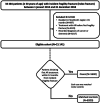Real-World Effectiveness of Anti-Resorptive Treatment in Patients With Incident Fragility Fractures-The STORM Cohort-A Swedish Retrospective Observational Study
- PMID: 34984745
- PMCID: PMC9305222
- DOI: 10.1002/jbmr.4498
Real-World Effectiveness of Anti-Resorptive Treatment in Patients With Incident Fragility Fractures-The STORM Cohort-A Swedish Retrospective Observational Study
Abstract
Results from real-world evidence (RWE) from the largest healthcare region in Sweden show low uptake of antiresorptive (AR) treatment, but beneficial effect in those receiving treatment, especially for the composite outcome of hip fracture or death. For RWE studies, Sweden is unique, with virtually complete coverage of electronic medical records (EMRs) and both regional and national registries, in a universal publicly funded healthcare system. To our knowledge, there is no previous RWE study evaluating the efficacy of AR treatment compared to no AR treatment after fragility fracture, including data on parenteral treatments administered in hospital settings. The Stockholm Real World Management (STORM) study cohort was established in the healthcare region of Stockholm to retrospectively assess the effectiveness of AR treatment after first fragility fracture using the regional EMR system for both hospital and primary care. Between 2012 and 2018, we identified 69,577 fragility fracture episodes among 59,078 patients, men and women, 50 years and older. Of those, 21,141 patients met inclusion and exclusion criteria (eligible cohort). From these, the final matched study cohort comprised 9840 fragility fractures (cases receiving AR treatment [n = 1640] and controls not receiving AR treatment [n = 8200]). Propensity scores were estimated using logistic regression models with AR treatment as outcome and confounders as independent variables followed by analysis using Cox proportional hazard models. Real world evidence from Sweden's largest healthcare region, comprising a quarter of the Swedish population, show that only 10% of patients receive AR treatment within 1 year after a fragility fracture. Factors associated with not receiving treatment include having a diagnosis of cardiovascular disease. In those treated, AR have positive effects particularly on the composite of fracture and death (any fracture/death and hip fracture/death) in individuals matched for all major confounders. © 2022 The Authors. Journal of Bone and Mineral Research published by Wiley Periodicals LLC on behalf of American Society for Bone and Mineral Research (ASBMR).
Keywords: ANTIRESORPTIVES; FRACTURE PREVENTION; GENERAL POPULATION; OSTEOPOROSIS; REAL WORLD EFFECTIVENESS.
© 2022 The Authors. Journal of Bone and Mineral Research published by Wiley Periodicals LLC on behalf of American Society for Bone and Mineral Research (ASBMR).
Conflict of interest statement
BF was an employee at Amgen 2009–2016; he has served on advisory boards for Amgen, UCB, Eli Lilly, MSD, and Novartis. MKS was employed by Amgen AB when the study was performed. TC is co‐founder of an independent statistical consultant company, Sence Research AB, Uppsala, which has received funding from Amgen AB for statistical analysis for this research project. LL and HJ report no potential conflicts of interest for this study. AK has served on advisory boards for Amgen, UCB, and Amicus, and has received speaker fees or is a previous recipient of research grants from Amgen, UCB, Sanofi‐Genzyme, Shire‐Takeda and GMPO/Orphalan.
Figures


References
-
- Osteoporosis: assessing the risk of fragility fracture . 2017. London, UK: (NICE Clinical Guidelines, No. 146) National Institute for Health and Care Excellence (NICE). http://www.ncbi.nlm.nih.gov/books/NBK554920/. - PubMed
-
- Hernlund E, Svedbom A, Ivergård M, et al. Osteoporosis in the European Union: medical management, epidemiology and economic burden. A report prepared in collaboration with the International Osteoporosis Foundation (IOF) and the European Federation of Pharmaceutical Industry Associations (EFPIA). Arch Osteoporos. 2013;8:136. - PMC - PubMed
-
- Abrahamsen B, van Staa T, Ariely R, Olson M, Cooper C. Excess mortality following hip fracture: a systematic epidemiological review. Osteoporos Int. 2009;20(10):1633‐1650. - PubMed
-
- Socialstyrelsen . Hälso‐ och sjukvård vid kroniska sjukdomar [National Board of Health and Welfare (Socialstyrelsen). Healthcare in chronic conditions] [Internet]. https://www.socialstyrelsen.se/globalassets/sharepoint-dokument/artikelk...
Publication types
MeSH terms
LinkOut - more resources
Full Text Sources
Medical
Research Materials
Miscellaneous

